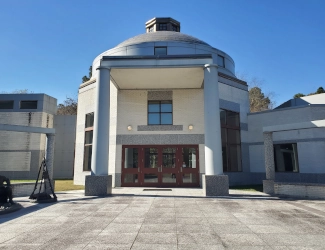
Image above: Entrance to the National Museum of the Civil War Soldier, 2024. Courtesy America's Best History.
Spotlight on Lesser Known History
Pamplin Historical Park, Virginia
America's Best History Spotlight
On this page we're going to Spotlight the lesser known historic sites and attractions that dot the history landscape across the USA and are worth a visit if you're in their area. And while they may be lesser known, some are very unique, and will be that rare find. You'll be, at times, on the ground floor, or maybe even know something others don't. It'll be fun. Visit them.

Pamplin Historical Park, Virginia
Pamplin Park, a private Civil War history and period history park has museums, films, exhibits, period buildings, and the exact location where General Grant's Army finally broke through the defenses of General Lee around Petersburg and Richmond to storm the capitol, precipitating the end of the Civil War one week later in the McLean House at Appomattox Court House.
It is officially known as, and well so, Pamplin Historical Park, and the National Museum of the Civil War Soldier. For most fans of this part of American history, it is best known as the premier place to visit around the sites of the siege of Petersburg and Richmond, as the most intact place to see earthworks (arguments could be made about Hatcher's Run), and the only place to walk through the location where the breakthrough began.
Photo above: Soldier Exhibit Outside the Museum Entrance, 2024. Courtesy America's Best History.
Sponsor this page. Your banner or text ad can fill the space above.
Click here to Sponsor the page and how to reserve your ad.
Info, What's There Now, History Nearby
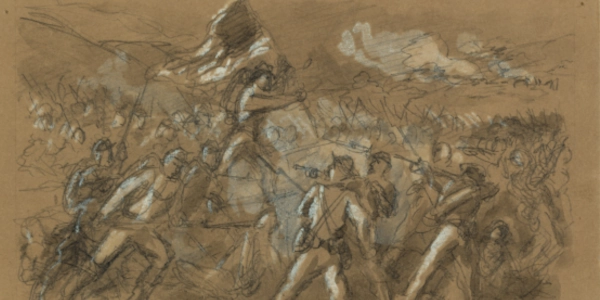
Pamplin Park, Virginia
This park has not been around forever, although since 1991, it has grown into an over four hundred acre historical park that preserves Civil War earthworks, including the Breaktrough acres by the 5th Vermont Infantry as General Grant pushed his entire Army in one coordinated attack against the Confederate line in the early morning hours, starting time 4:30 a.m., from east to west and south to north. By the end of that day, the Confederate Army was in retreat from Petersburg and Richmond, heading west, but hoping to meet up with their Army in the South.
Pamplin Park, as well as the Petersburg National Park, has preserved almost all of the land of the Third Battle of Petersburg, of which the Breakthrough was part. The historical park now has saved various Antebellum structures, as well as built three interpretive museums. It is a day worth spending, particularly during the days in late March and early April when they participate in commemorating the anniversary dates of the Breakthrough.
Image above: Drawing of the Petersburg/Richmond Breakthrough, 1865, Alfred Waud. Courtesy Library of Congress. Below: Map of the Petersburg breakthrough, 2011, Map by Hal Jespersen, www.posix.com/CW. Courtesy Wikipedia Commons C.C. 3.0.
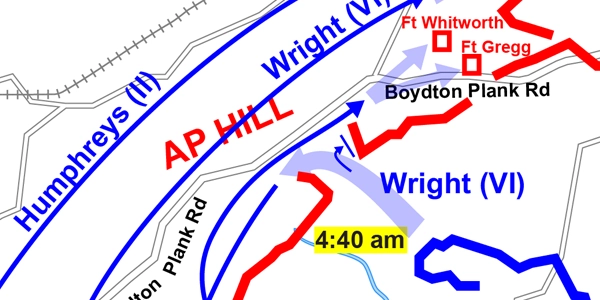
Where Is It
Pamplin Park is located at 6125 Boynton Plank Road, Petersburg, Virginia 23803. This is southwest of Richmond and in the area of Northwest Petersburg.
Minute Walk in History
General Grant and almost his entire Army of the Potomac had been surrounding Richmond and Petersburg for six months. Now, on April 2, 1865, the breakthrough occurred on the Petersburg line south of town. It is now represented by an awesome private park and museum, Pamplin Park, which should be visited next time you travel to the area for Civil War history or just history in general. With museum displays in several buildings and the outbuildings and main house of the landowners during the war, the many paths lead you to the exact location where the first Union man crossed the heavy Confederate defenses.
What is There Now
Pamplin Park, Virginia
There is so much to see, both interior and exterior, at one of the best heritage sites in the nation. You will enter the Visitor Center or National Museum of the Civil War Soldier, the Battlefield Center, Education Center, as well as the Tudor Hall Plantation, Hart Farm, Banks House (used by Grant after the breakthrough), as well as the Breakthrough Trail taking you to the trenches where the breakthrough occurred. There are many other trails, too. Two hours to do them all. And that does not include the entire day if you take in all the exhibits and programs.
When Open and How Much
Pamplin Park has suffered a bit of a downturn in admissions lately, so opening is varied, particularly in the winter. Please contact the park before going to see what their schedule is for that time, or any time, of the year. There is a $15 fee for adults, $8 for 6 to 12, and free under that.
Fees and hours are subject to change.
Website
Pamplin Park
History Nearby
Although we could get into the vast amount of historical sites in this area that are not Civil War related, we'd be remiss to note that most are exactly that. Whether you are within Richmond National Battlefied, Petersburg National Battlefield, the additional land saved by the American Battlefield Trust, or elsewhere, the area, despite vast intrusive development at many historic sites, tells the story about how General U.S. Grant surrounded the two towns in 1864 and sieged them until the breakthrough at Pamplin Park on April 2, 1865.
Photos, History, and More Spotlights
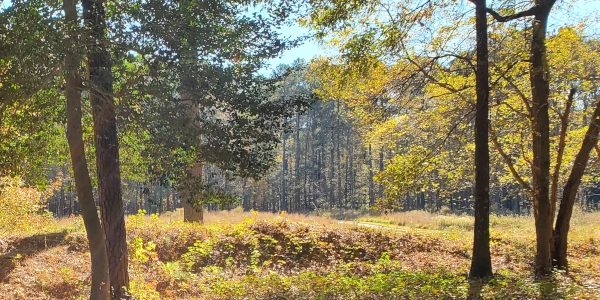
History of the Breakthrough
General U.S. Grant had been sieging Petersburg and Richmond for 292 days before he would achieve his goals. On March 29, Grant had his plans for an offensive made; an open battle drawing the Confederates out of their lines. He ordered General Ord from the Army of the James to fill a gap that General Humphreys' 2nd Corps would make as they moved west. Two Corps of Meade's Army of the Potomac would then be free; Humphreys' 2nd Corps and General Warren's 5th Corps. There were several battles in the interim before they could get to their April 2, 1865 morning attack; the Battle of Lewis Farm, White Oak Road, Dinwiddie Court House, and Five Forks.
After the Battle of Five Forks ended on April 1, Colonel Horace Porter reported to Grant that they had been victorious and opened the path to the South Side Railroad. This allowed Generals Humphrey and Parke to be ready to push the Confederate line, and for a general assault to be ordered. It was. At 4:00 a.m., Humphrey's 2nd Corps, Wright's 6th Corps, Parke's 9th Corps, and Gibbon's 24th Corps from the Army of the James were directed to attack the trenches opposite them.
Wright attacked the Confederate line across a clearing; it was heavily defended with batteries, but their approach was covered to within twenty-five hundred yards of the trenches, which stretched for one mile along his front. There was a clear Union advantage in troops with the 6th Corps including 14,000 men against the Confederates 2,800. His three divisions formed a wedge at 4:00, but held until better light at 4:40. They did not know the lightness of the Confederate force as they stood six hundred yards from the pickets and six hundred more yards to the main line.
The 1st Vermont Brigade led the assault, with the picket line of the Confederates overrun quickly. Toward the main line, the Vermonters marched. The Breakthrough occurred rapidly, with Captain Charles G. Gould of the 5th Vermont Infantry the first man breaching the line, followed by fifty other men.
Photo above: Trenches at Location of the Union Breakthrough, April 2, 1865, 2024. America's Best History
Buy Second Edition
America's Best History Timeline

Great book to keep middle school to college students up to date on their American history.
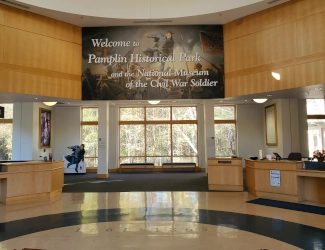
History of Pamplin Park
In 1990, this tract of land was first put up for sale. Civil War preservationists knew how important it was, with the intact breastworks where Grant's 14,000 men first charged through the Petersburg defenses, today known as the Breakthrough. By 1991, the park was purchased, with the forerunner to today's American Battlefield Trust, then known as the Association for the Preservation of Civil War Sites, contacting Dr. Robert B. Pamplin, Jr., owner of a Fortune 400 company, that his ancestral home and land were for sale. Dr. Pamplin bought the first one hundred acres and donated $5 million toward construction of the heritage park.
The park was opened in June 1994 with a one mile trail and interpretive center. In 1999, the park had grown to include the National Museum of the Civil War Soldier, twenty-five thousand square feet, on a total of three hundred and sixty-three acres. Today, after more purchases, the park hold four hundred and twenty-four acres of preserved land.
Image above: Interior lobby of the National Museum of the Civil War Soldier, 2024. Courtesy America's Best History. Below: Tudor House at Pamplin Park, 2024. Courtesy America's Best History.
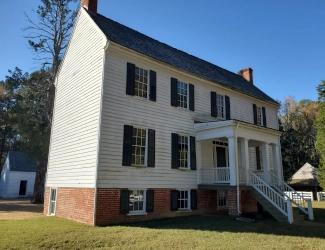
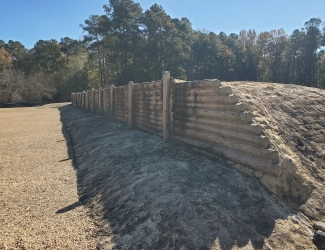
First Soldier Through
Charles Gilbert Gould, a captain in Company H of the 5th Vermont, climbed over the earthworks, the first Union soldier to cross into the Confederate line of the siege. The fourteen thousand troops within the 6th Corps under General Wright followed through along their front. Gould was injured, stabbed three times, twice in the head, but he made it back alive with help from his colleagues after a Confederate officer's gun did not fire at point blank range. In 1890, Major Charles Gilbert Gould was given the Medal of Honor for his actions on April 2, 1865.
"The President of the United States of America, in the name of Congress, takes pleasure in presenting the Medal of Honor to Captain (Infantry) Charles Gilbert Gould, United States Army, for extraordinary heroism on 2 April 1865, while serving with Company H, 5th Vermont Infantry, in action at Petersburg, Virginia. Among the first to mount the enemy's works in the assault, Captain Gould received a serious bayonet wound in the face, was struck several times with clubbed muskets, but bravely stood his ground, and with his sword killed the man who bayoneted him."
Photo above: Example of the breastworks and fortifications used during the sieges on both Union and Confederate sides. These had rarely been used prior to 1864 and are more known as World War I trench warfare, 2024. Courtesy America's Best History.

T-Shirts and Gifts from the official souvenirs of Americasbesthistory.com.
About
America's Best History where we take a look at the timeline of American History and the historic sites and national parks that hold that history within their lands.
Photos courtesy of the Library of Congress, National Archives, National Park Service, americasbesthistory.com and its licensors.
- Contact Us
- About
- © 2025 Americasbesthistory.com.
Template by w3layouts.


